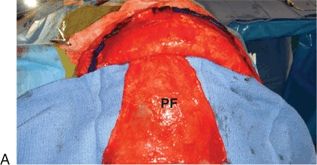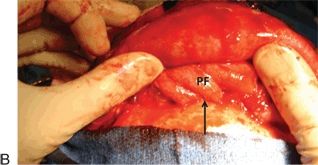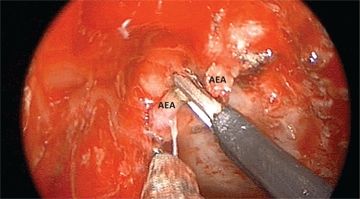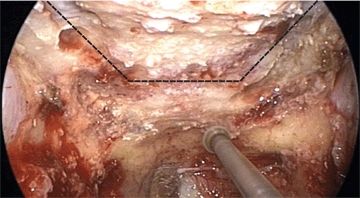FIGURE 12.1 Sagittal CT (computed tomography) angiogram showing the relationship of the anterior cerebral arteries (arrow) with a large olfactory groove meningioma. Notice also the hyperostosis (dashed arrow) of the planum.
Preoperative embolization is not necessary for most tumors of the anterior skull base when the tumor is approached endonasally. The main blood supply is usually the anterior and/or posterior ethmoid arteries. These are easily accessed during an endoscopic endonasal approach, providing good control and early devascularization.
If the patient has significant papilledema, especially when associated with ventriculomegaly, ventriculoperitoneal shunt placement should be considered to allow for maximum decompression and preservation of vision while awaiting resolution of cerebral edema and also to assist with healing of the resultant skull base defect following tumor removal.
SURGICAL TECHNIQUE (VIDEO 12.1)
Positioning is critical for an endoscopic approach to the cribriform area. The patient’s head must be adequately extended to allow access to the anterior-most aspect of the anterior cranial base without the operator’s hands and instruments colliding with the patient’s chest. This will also help the flap or reconstruction graft to stay in place with gravity as an aid during placement.
The major advantage of an endonasal approach to the anterior skull base is based on the fact that the tumor originates from, involves, or is in contact with the skull base directly adjacent to the ethmoid sinuses. Therefore, the approach is via a tailored ethmoidectomy. This can range from sphenoidotomy and posterior ethmoidectomy for access to the planum sphenoidale to full anterior and posterior ethmoidectomies with frontal sinusotomy. Lateral extension can be accessed by adding maxillary antrostomies and removal of the laminae papyraceae. When in doubt, wider exposure and access is always valuable as it improves the visualization, orientation, and working room. If a tumor extends close to the posterior table of the frontal sinus, a frontal sinusotomy (Lothrop or Draf 3) should be performed. This significantly improves orientation by providing a clear anterior border/landmark and may prevent postoperative obstruction of the frontal sinus.
The technique for reconstruction must be planned prior to the surgery. With aggressive malignancies such as many cancers of the sinonasal tract, a nasal septal flap is not a good option due to possible tumor involvement. However, in select ENBs, if there is a radiographic, gross endoscopic, and histopathologically negative margin on a contralateral septal flap, it can be used. If the flap is inadequate for complete coverage, it can be supplemented by a nonvascularized autograft such as fascia lata or allograft-like cadaveric dermis (Alloderm) covering the entire defect with the vascularized flap overlying (superficial to) a portion of this graft. The vascularized flap seems to greatly improve healing of the nonvascularized portion. Otherwise, an extracranial pericranial flap should be planned and used without hesitation (Fig. 12.2). This flap can be placed “extracranially” without a craniotomy by passing it through an opening at the level of the nasion below the plane of the skull base (in contrast to a traditional pericranial flap that is technically intracranial).


FIGURE 12.2 Intraoperative photographs showing a vascularized pericranial flap (PF) after harvest (A) and after tunneling through a nasion osteotomy (B). Arrow points to edge of osteotomy.
Once tailored sphenoethmoidectomies have been performed, the overlying skull base can be removed. The first step in this is to locate, control, and ligate the ethmoid arteries (Fig. 12.3). This also serves to devascularize the tumor as these vessels typically supply the vast majority of any cribriform tumor. The posterior ethmoid artery can be found approximately one-half centimeter anterior to the optic nerve, and it runs slightly posteriorly as it passes from lateral to medial. The anterior ethmoid artery (AEA) (which runs obliquely anteriorly as it passes from lateral to medial) can also be located by removing adjacent lamina papyracea and ligating the artery at its exiting foramen. Care should be taken to completely coagulate the stump of the ethmoid arteries to avoid postoperative retrobulbar hematoma. Once the arteries are controlled, osteotomies can be performed bilaterally with a high-speed drill and coarse diamond burr just medial to the orbit (Fig. 12.4). These are connected posteriorly across the planum sphenoidale or tuberculum sellae as needed. Finally, anterior osteotomies are made just behind the posterior wall of the frontal sinus, extending to the crista galli. Once complete, these will allow bilateral anterior cranial plates, separated by the cribriform plate, to be dissected free from the overlying dura and removed. The planum sphenoidale and tuberculum sella may be removed separately.

FIGURE 12.3 Intraoperative endoscopic view showing bipolar coagulation of a ligated right anterior ethmoidal artery (AEA).

FIGURE 12.4 Intraoperative endoscopic view following complete ethmoidectomy showing the anterior cranial base from below. The osteotomies that have been drilled are highlighted with dotted lines.
Removal of bone laterally can be extended with a 45-degree Kerrison rongeur to the midorbit if the lamina papyracea has been removed. This will allow complete exposure of all involved dura in most cases, thereby obviating the need for an open approach. The dura and bulky tumor can now be coagulated with pistol-grip bipolar electrocautery to maximize hemostasis and tumor devascularization. Finally, the crista galli can be dissected free and then removed with either a drill and dissectors or Kerrison rongeur, depending upon the height. Ideally, the dura will be dissected free before the crista galli is detached, as this dissection becomes much more difficult once it is free floating.
Stay updated, free articles. Join our Telegram channel

Full access? Get Clinical Tree


